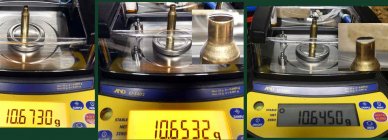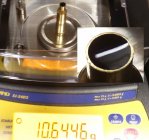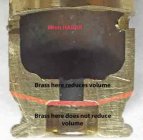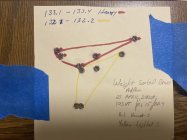Not sure of the physics,I watched video. It seems to do as it says it does. Who really knows but I like it.Don,
The Bison Armory capacity die: https://bisonarmory.com/bison-armory-case-volume-gauge/
Very interesting! Looks like two pcbs each having a pressure sensor. Are they just measuring the air pressure inside the case, from the point where the case seals to the die surfaces on the upstroke? If so, how consistently can one case seal to the next? At the same height I mean, etc. Maybe I’m missing some important detail.
You are using an out of date browser. It may not display this or other websites correctly.
You should upgrade or use an alternative browser.
You should upgrade or use an alternative browser.
Questions about Weight-Sorting Cases
- Thread starter South Pender
- Start date
CharlieNC
Gold $$ Contributor
Over the years data has been presented showing a strong correlation between volume and weight, and data showing no correlation. It depends upon the range of weight variability. If the brass varies by +/-0.1 gr then not, while +/-10 gr will correlate. Rather than a blanket statement, this situation varies "case by case". Weight sorting brass is so fast and simple it doesn't make sense not to do it, especially considering finding problematic outliers.
Inverted spent primer.
BuffaloBill
Silver $$ Contributor
Sorry, I didn’t see the video link till just now. I see this uses it’s own piston to displace a fixed amount of air. It doesn’t rely on the case body sealing to the die as I first imagined. Very cool!Not sure of the physics,I watched video. It seems to do as it says it does. Who really knows but I like it.
Exactly , if it gives you confidence and you shoot better , snake oil or not , it sure isn't hurting or even costing anything other than time.... I have never weight sorted primers either.... I do also sort my bullets by lengths from base to ogive and saw improvement with that... I understand that competition is tough so any advantage is worth it but I only shoot for fun basically against myself anymore but it's nice to try new things and shoot tighter groups that's for sure....A lot can be said for the mental game. I also weight sort cases and
bullets. Winter was hard this year so it helps pass the time. Now I just
shot a .628" group at 500 yards and repeated with .871" group using
this method. I wonder if they would have been tighter if I weight sorted
my BR2's.....?? We'll save that argument for another day !!
Just for instance , I got hot and heavy into shooting skeet when COVID first started... I could find reloading stuff for shotshell at that time and couldn't find anything basically for rifle or pistol... I , over the couple years worked up my skeet load and have a specific way I seat the shot in the cup before crimping it shut.... Every since I started doing it that way my score went up a bunch... Last Tuesday I was running late and didn't have time the night before and just loaded my shotshells fast and just ran them through the machine , crimping and moving on to get done.... That Tuesday I shot like crap with those shells , same powder etc etc etc as always but not the extra steps.... Now I don't know if those extra steps mean anything but I think I will stick with doing them... Even though we were shooting in hurricane force winds on a crappy overcast day etc I blame the shotshells...lol
Mulligan
Silver $$ Contributor
I suspect there are several ways to sort brass and they likely all will work.
I read on a thread on this forum that at least one shooter is sorting his brass by actual measured velocity. So simple, it’s brilliant.
CW
Edit
It to include link
Post 19 by @BartsBullets
CW
OP, I’m not sure it this will help or not. Your brass is so close in weight that you are likely just separating fly pop from pepper anyway……… unless you are shooting long range benchrest…. If that’s the case, sort three ways from hades and buy some magic potion from a witchy women.
Good luck
CW
I read on a thread on this forum that at least one shooter is sorting his brass by actual measured velocity. So simple, it’s brilliant.
CW
Edit
It to include link
Sorting match cases by H2O capacity
When setting up for a new LR rifle or barrel, I normally fully prep a bunch of brass. After squaring primer pockets, trimming to length, turning necks, etc., I then wash the brass to remove all lubricant and any remaining brass particles before weighing. I start with a large enough number of...
forum.accurateshooter.com
CW
OP, I’m not sure it this will help or not. Your brass is so close in weight that you are likely just separating fly pop from pepper anyway……… unless you are shooting long range benchrest…. If that’s the case, sort three ways from hades and buy some magic potion from a witchy women.
Good luck
CW
Last edited:
If you are absolutely confident in your equipment, reloading, and shooting skills this is probably the correct way. But you have to nail everything for this to be true. To the kernel charge weights, dimensionally consistent brass, consistent neck tension, seating depth, bearing surface and weight sorted bullets, primer lot, primer seating depth, how much shoulder you give the gun, ect. All need to be consistent to the point that the variable in the test is only the brass itself. For shooters with competition level equipment and tens of thousands of rounds down the pipe it can be a valid test and pick up things other methods could not possible detect such as brass body hardness.I suspect there are several ways to sort brass and they likely all will work.
I read on a thread on this forum that at least one shooter is sorting his brass by actual measured velocity. So simple, it’s brilliant.
CW
Edit
It to include link
Post 19 by @BartsBulletsSorting match cases by H2O capacity
When setting up for a new LR rifle or barrel, I normally fully prep a bunch of brass. After squaring primer pockets, trimming to length, turning necks, etc., I then wash the brass to remove all lubricant and any remaining brass particles before weighing. I start with a large enough number of...forum.accurateshooter.com
CW
OP, I’m not sure it this will help or not. Your brass is so close in weight that you are likely just separating fly pop from pepper anyway……… unless you are shooting long range benchrest…. If that’s the case, sort three ways from hades and buy some magic potion from a witchy women.
Good luck
CW
For most shooters (myself included) there is too much variance in the equipment and shooter to pin the variance on the brass. A standard full length die with no expander to uniform exterior dimensions, trim to length, turn to uniform neck thickness, uniform flash holes and primer pockets. That's every surface and dimension as controlled as we can get it. Then a weight sort or volume sort will likely produce a more accurate result for most.
Understood, but deburring is one thingYeah, the tool I used is an inside deburring tool
Chamfering is something else
If your old enough to recall 4 bbl Holley carbs the main jets when sold could have the same size hole but an entirely different angle leading up to that hole. In this case it’s not just the hole but whatever angle may be there I don’t wish to change.
To measure volume I assume water is used, correct? The few times I’ve done that, I wasn’t sure how to best be consistent from one to the next, regarding surface tension; how high the water domes, etc. What advice does everyone have for me on that detail?
Some of us use fine whisky.
probably not at 500..at 1000 yes sorted primers help consistancyA lot can be said for the mental game. I also weight sort cases and
bullets. Winter was hard this year so it helps pass the time. Now I just
shot a .628" group at 500 yards and repeated with .871" group using
this method. I wonder if they would have been tighter if I weight sorted
my BR2's.....?? We'll save that argument for another day !!
not on the inside of most common cases.Understood, but deburring is one thing
Chamfering is something else
If your old enough to recall 4 bbl Holley carbs the main jets when sold could have the same size hole but an entirely different angle leading up to that hole. In this case it’s not just the hole but whatever angle may be there I don’t wish to change.
burrs are common on common brqass, no burrs on better bgrass
i have yet to see a "nozzel' in a case
LVLAaron
Gold $$ Contributor
Perhaps I can re frame the question. For you guys who do weight-sort your cases, would you consider a case weight variation of .5 gr. in a set of five you shot for group (say 6.5x55 cases weighing on average 177 gr.) to be sufficiently close in weight to eliminate case volume as a variable?
Depends what I have and what I'm trying to do.
If I have 100 cases for something I don't use a lot, I might take the top and bottom 10 cases and set them aside for the end of the world.
For my FTR brass, I buy 500 at a time, and sort them into batches of 75 with a couple left over - set aside for the end of the world.
If I want a batch of brass that I know will be perfect, I go to the trouble of sorting by volume. A lot more work for questionable return, but I feel good about it.
Something I was always interested in but never tried since I don’t shoot competition and I am not OCD. Take an electronic scale and make a support about 2 inches off of the scale. Better yet make a support that allows the neck or base of the case to touch the center of the scale and the other end is off of the scale with the case level. Do this with new cases so they don’t have carbon in them. Weigh the cases with neck on the scale and head on the scale. Never been done before. This would give you an idea of how much the none volume contributing head wt. variation there is. I will do this. I have 100 new Lapua 6mmBR cases.I'm prepping new cases for my 6.5x55 and have chamfered the flashholes, trimmed them to the same length, and neck-turned them. These are Lapua cases, and I weighed 40 and found them all to be within about 1 gr. in weight--from a low of 176.8 gr. to a high of 177.9. I thought I'd sort them into two groups--the lightest 20 and the heaviest 20. If I do it this way, the weight variation in each group of 20 will be about .5 gr.
Here are my question:
1. Is this sorting worth the effort? To be sure, it didn't take much time, but if I passed on the sorting I'd have cases varying by up to 1 gr. in weight in groups shot.
2. In my two groups of 20 cases--with the variation in each of the two groups of 20 cases running .5 gr.--is this sufficient closeness in case weight for you guys shooting competitively? That is, in any group of 5 shot, the maximum case weight variation would be .5 gr., and in some groups shot, it would be less than that.
Later:
Just tried it with a piece of plastic off of the scale to support one end. It doesn't work. Placement of a small variation and the edge of the scale produce to much variation. You need make a holder so off end of the case is always at the same exact location and the case end is near the center of the scale.
Last edited:
actually you have to build a tool that is adjustable to support one end..LEVEL with the other while weighing. we do this with connecting rods when building a balanced motor.....all big ends weigh the same, all small ends weigh the same. big end is rotating mass, small end is notSomething I was always interested in but never tried since I don’t shoot competition and I am not OCD. Take an electronic scale and make a support about 2 inches off of the scale. Better yet make a support that allows the neck or base of the case to touch the center of the scale and the other end is off of the scale with the case level. Do this with new cases so they don’t have carbon in them. Weigh the cases with neck on the scale and head on the scale. Never been done before. This would give you an idea of how much the none volume contributing head wt. variation there is. I will do this. I have 100 new Lapua 6mmBR cases.
Later:
Just tried it with a piece of plastic off of the scale to support one end. It doesn't work. Placement of a small variation and the edge of the scale produce to much variation. You need make a holder so off end of the case is always at the same exact location and the case end is near the center of the scale.
@Webster Take a scrap case and remove 1 grain from the groove with a file.
See if that is something you would notice.
Trim a case 0.010", weight the loss. Does that reduce the loaded volume (same OAL) or just a little brass?
Remove flash hole burrs. Can you measure the brass loss? Does loss here increase internal volume?
Groove and rim are below the case volume and would be dead weight.
Top of primer pocket to base of case is pretty much a constant.
Web thickness raises the floor and cuts down volume.
Look at a cross section and see where brass would reduce volume and where it would not.
I question the precision and correlation of most water volume measurements I've seen.
A half grain difference in case weight (in the body) would be close to 0.06 grains of water.
(Brass be much heavier than water )
)
In other words, a chart showing half grain increments in case weight, should show 0.004 grams of water weight (0.004cc)
A dirty case will have micro pockets of air caught in the rough surface. That's why lab glass cleanliness is critical. A wetting agent is good for air bubbles but not micro bubbles caught in a rough dirty case.
Here are some 6mm Hagar cases with a reversed spent primer.
Weights are in grams. Meniscus variation is 0.028 grams, or 0.431 grains.
Note the straight line reflection in the last case.
(Used 6bra1k tissue wick method )
)

I'll dry and redo this to see if I can repeat the measurement.
Notice the ever so slight negative meniscus.
Fairly repeatable

With the concave shape the actual weight of a full case is probably a milligram heavier than indicated or 10.6454g or so. The empty, with spent primer is 8.3442 grams. Water weight of a full case would be 35.512grains.
EDIT:
Did a slightly heavier case. Rounding to 3 decimal places (nearest 1mg)
First case was 8.344g empty, 10.645g full=2.301 cc (35.509 grains of water)
Next case was 8.584g empty, 10.860g full=2.276cc (35.1245 grains of water)
8.584-8.344=0.24 grams of brass difference, 2.301-2.276=0.025 grams of water difference.
Brass to water 9.6 to 1.
Sounds reasonable to me
Dead weight vs volume reducing weight. Where is the most likely place to find a few extra grains of brass?
Rim and groove?

See if that is something you would notice.
Trim a case 0.010", weight the loss. Does that reduce the loaded volume (same OAL) or just a little brass?
Remove flash hole burrs. Can you measure the brass loss? Does loss here increase internal volume?
Groove and rim are below the case volume and would be dead weight.
Top of primer pocket to base of case is pretty much a constant.
Web thickness raises the floor and cuts down volume.
Look at a cross section and see where brass would reduce volume and where it would not.
I question the precision and correlation of most water volume measurements I've seen.
A half grain difference in case weight (in the body) would be close to 0.06 grains of water.
(Brass be much heavier than water
In other words, a chart showing half grain increments in case weight, should show 0.004 grams of water weight (0.004cc)
A dirty case will have micro pockets of air caught in the rough surface. That's why lab glass cleanliness is critical. A wetting agent is good for air bubbles but not micro bubbles caught in a rough dirty case.
Here are some 6mm Hagar cases with a reversed spent primer.
Weights are in grams. Meniscus variation is 0.028 grams, or 0.431 grains.
Note the straight line reflection in the last case.
(Used 6bra1k tissue wick method

I'll dry and redo this to see if I can repeat the measurement.
Notice the ever so slight negative meniscus.
Fairly repeatable

With the concave shape the actual weight of a full case is probably a milligram heavier than indicated or 10.6454g or so. The empty, with spent primer is 8.3442 grams. Water weight of a full case would be 35.512grains.
EDIT:
Did a slightly heavier case. Rounding to 3 decimal places (nearest 1mg)
First case was 8.344g empty, 10.645g full=2.301 cc (35.509 grains of water)
Next case was 8.584g empty, 10.860g full=2.276cc (35.1245 grains of water)
8.584-8.344=0.24 grams of brass difference, 2.301-2.276=0.025 grams of water difference.
Brass to water 9.6 to 1.
Sounds reasonable to me
Dead weight vs volume reducing weight. Where is the most likely place to find a few extra grains of brass?
Rim and groove?

Last edited:
My statement was made based on your use of the word “chamfer”.not on the inside of most common cases.
burrs are common on common brqass, no burrs on better bgrass
i have yet to see a "nozzel' in a case
If you chamfer your making a “nozzle”
I run into burrs occasionally on all makes including Lapua, too.
I'd be more interested in the neck tension. Who cares if the case weight varies a little?
John
John
Similar threads
- Replies
- 67
- Views
- 9,120
Upgrades & Donations
This Forum's expenses are primarily paid by member contributions. You can upgrade your Forum membership in seconds. Gold and Silver members get unlimited FREE classifieds for one year. Gold members can upload custom avatars.

Click Upgrade Membership Button ABOVE to get Gold or Silver Status.
You can also donate any amount, large or small, with the button below. Include your Forum Name in the PayPal Notes field.
To DONATE by CHECK, or make a recurring donation, CLICK HERE to learn how.

Click Upgrade Membership Button ABOVE to get Gold or Silver Status.
You can also donate any amount, large or small, with the button below. Include your Forum Name in the PayPal Notes field.
To DONATE by CHECK, or make a recurring donation, CLICK HERE to learn how.










